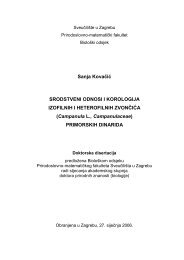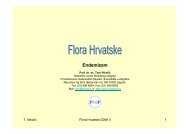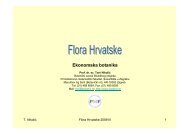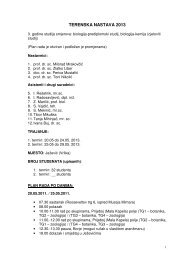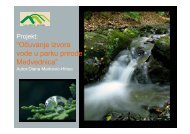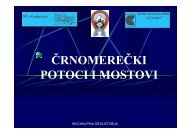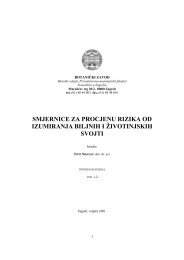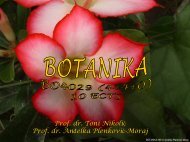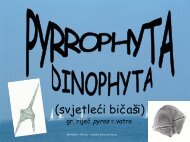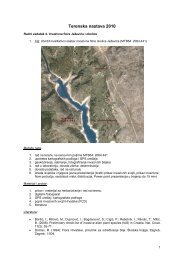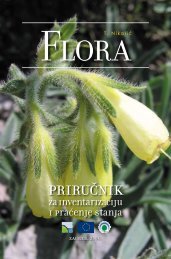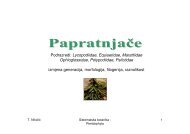important plant areas in central and eastern europe - hirc.botanic.hr ...
important plant areas in central and eastern europe - hirc.botanic.hr ...
important plant areas in central and eastern europe - hirc.botanic.hr ...
You also want an ePaper? Increase the reach of your titles
YUMPU automatically turns print PDFs into web optimized ePapers that Google loves.
MethodologyLichensThere were 34 lichen species <strong>in</strong>cluded <strong>in</strong> the IPA species list for the seven partnercountries <strong>and</strong> they are qualify<strong>in</strong>g features on 24 IPAs. The 1989 European Red List forMacro-lichens was used <strong>in</strong> this project, however this red list is now quite old <strong>and</strong> anupdated European red list would certa<strong>in</strong>ly help to identify priority lichen species <strong>and</strong>sites. Lichens were also <strong>in</strong>cluded <strong>in</strong> this project <strong>in</strong> some countries under Criterion B<strong>and</strong> under certa<strong>in</strong> habitats <strong>in</strong> Criterion C. The availability of data was often a problemfor this group.FungiThe list of 33 fungi species prepared by the European Committee for the Conservationof Fungi (ECCF) were <strong>in</strong>cluded <strong>in</strong> the list for Criterion A. Fungi are recorded asqualify<strong>in</strong>g features <strong>in</strong> 20 IPAs under Criterion A. There are significant differences <strong>in</strong> thespecialist discipl<strong>in</strong>es <strong>and</strong> <strong>in</strong> the conservation needs of <strong>plant</strong>s <strong>and</strong> fungi, so <strong>in</strong> eachcountry the mycologists made the decision on whether there was sufficient data <strong>and</strong> if itwas appropriate to identify priority <strong>plant</strong> <strong>and</strong> fungi sites together or separately. Aga<strong>in</strong> itwas also possible to identify sites for fungi conservation us<strong>in</strong>g Criterion B <strong>and</strong> CriterionC. In Estonia several sites were identified primarily for the importance of their fungi.Lack of data was a significant problem for fungi <strong>in</strong> this project.A European red list forfungi would help to identify priority species for conservation, <strong>and</strong> specific recognition forfungi <strong>in</strong> European legislation <strong>and</strong> policies would also help <strong>in</strong> their conservation.AlgaeAlgae are poorly represented <strong>in</strong> the project, primarily because of the lack of data <strong>and</strong>the under-representation of algal species on national <strong>and</strong> regional conservation lists.TheBern Convention lists 12 algae species, although none of these occurred <strong>in</strong> the partnercountries, <strong>and</strong> none are recognised <strong>in</strong> the EU Habitats Directive. However <strong>in</strong> Estonia,t<strong>hr</strong>ee sites have been proposed as IPAs entirely for their mar<strong>in</strong>e algae species, underCriterion B.A European red list for algae would also help to prioritise conservationaction for this group.Methodology challenges:Putt<strong>in</strong>g theory <strong>in</strong>to practice is always a challeng<strong>in</strong>g experience <strong>and</strong> much valuable<strong>in</strong>formation has been ga<strong>in</strong>ed <strong>in</strong> the process of implement<strong>in</strong>g the seven national projects<strong>and</strong> <strong>in</strong> other pilot projects.These experiences will be used to ref<strong>in</strong>e the methodology<strong>and</strong> prepare guidance <strong>in</strong>formation for new countries. The most common methodologicalchallenges are:• Lack of recent <strong>and</strong> accessible data for species <strong>and</strong> habitats• Lack of red lists at the national <strong>and</strong> regional level• Decid<strong>in</strong>g on the number <strong>and</strong> area of IPAs <strong>in</strong> each country• Def<strong>in</strong><strong>in</strong>g practical boundariesOpen methodological discussions among specialists, <strong>and</strong> transparency <strong>in</strong> site selectionhave been strong po<strong>in</strong>ts of this project.The reasons for identify<strong>in</strong>g sites as IPAs aremade available to all, <strong>and</strong> with the rigorous selection of species <strong>and</strong> habitats under thecriteria there can be no doubt about the importance of these sites.ReferencesAnderson, 2002 Identify<strong>in</strong>g ImportantPlant Areas <strong>in</strong> Europe: A Site SelectionManual <strong>and</strong> a Guide to develop<strong>in</strong>g criteria <strong>in</strong>other parts of the world.Evans, S., Marren, P. & Harper, M., 2002,Important Fungus Areas: a provisionalassessment of the best sites for fungi <strong>in</strong> theUnited K<strong>in</strong>gdom. Plantlife,Association ofBritish Fungus Groups, British MycologicalSociety.Palmer, M., & Smart, J., 2001, ImportantPlant Areas <strong>in</strong> Europe: Guidel<strong>in</strong>es for theSelection of Important Plant Areas <strong>in</strong> Europe.Planta Europa & Plantlife.Parmasto, E., Per<strong>in</strong>i, C., & Rahko,T., 2004,Attempts to <strong>in</strong>troduce fungi <strong>in</strong>to natureconservation activities (Presentation:Planta Europa IV Conference,Valencia(www.nerium.net))Plantlife International, 2003 TechnicalReport from 7 national IPA workshops <strong>in</strong>Central <strong>and</strong> Eastern Europe.(www.<strong>plant</strong>life.org.uk)Plantlife International, 2003 Report fromIPA CEE Regional Workshop <strong>in</strong> Bratislava,November 2003 (www.<strong>plant</strong>life.org.uk)Planta Europa 1995, Proceed<strong>in</strong>gs of the FirstEuropean Conference on the Conservation ofWild Plants, Hyères, France, 2-8 September1995 (Ed. John Newton). PlantlifePlanta Europa 1998, Second EuropeanConference on the Conservation of WildPlants, 9-14th June 1998, Uppsala, Sweden.(Ed. Hugh Synge & John Akeroyd) SwedishT<strong>hr</strong>eatened Species Unit & PlantlifePlanta Europa 2001, Third EuropeanConference on the Conservation of WildPlants, 23-28 June 2001, Pruhonice, theCzech Republic: Develop<strong>in</strong>g a PlantConservation Strategy for Europe. CzechAgency for Nature Conservation &L<strong>and</strong>scape Protection, Planta Europa, theCouncil of Europe.Stewart, N. F. 2004, Important StonewortAreas, An assessment of the best <strong>areas</strong> forstoneworts <strong>in</strong> the United K<strong>in</strong>gdom. PlantlifeInternational, Salisbury, U.K.19



